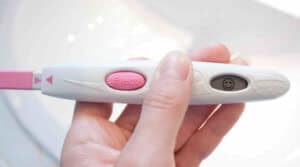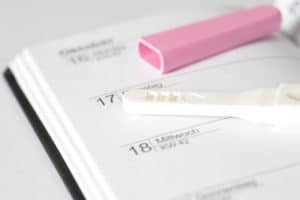Not all bleeding is the same. Some can cause concern and others are completely harmless and quite normal. Have you ever heard of abortion bleeding? Find out what it means and how it happens here.
Table of contents
What Is Abortion Bleeding?
During a withdrawal bleed – also called hormone withdrawal bleed – the lining of the uterus is shed. What sounds worrying actually happens once a month. In most cases, it is shorter and less weaker than the normal menstrual period.
The abortion bleeding occurs in the week in which you take a break from taking the pill. Due to the break in taking the pill, there is too little estrogen and progesterone in the body. As a result, the lining of the uterus that has built up by then can no longer be properly maintained.
Thus, bleeding occurs to shed the uterine lining. In fact, many women think that they have a normal menstrual period despite taking the pill. However, this is a misconception. This pseudomenstruation only occurs due to the lack of estrogen and progesterone.
Cessation Bleeding With Hormonal Contraception
Hormonal contraception provides fairly reliable protection against pregnancy. In addition to the pill, the vaginal ring, hormone implant, hormone ring or contraceptive patch can also be very effective. These methods also influence the development of the uterine lining.
If you do not use hormonal contraceptives, your uterine lining will be shed if fertilization of the egg has not taken place. This prepares your body for a new cycle.
Hormonal contraception therefore provides an “unnatural” abortion bleeding.
How Hormonal Contraception Affects Menstruation
Hormonal contraception adds synthetic hormones to your body. This creates a feedback process in the hypothalamus that prevents the body’s own hormones from being produced.
Thus, your hormone level is kept constant and controlled with the addition of hormones. This level, which is always the same, can also help in the treatment of cycle disorders, among other things. Especially when women suffer from very heavy or painful bleeding.
Did you know that the mode of action of hormonal contraceptives is based on inhibiting ovulation and liquefying the lining of the uterus? This is to prevent a fertilized egg from implanting.
Thus, a few steps of the monthly cycle are not skipped, but a condition is maintained to simulate successful fertilization.
Also interesting:
What Is The Difference Between Menstruation And Abortion Bleeding?
Natural menstruation and abortion bleeding differ in many ways. Natural bleeding occurs due to the natural shedding of the uterine lining. However, this happens only when fertilization has not occurred during the fertile days and no egg has nested in the uterus.
Another difference between menstruation and abortion bleeding is the intensity, duration and frequency. Have you ever wondered why your periods have become less intense since you started using hormonal contraceptives ?
This is because the uterus becomes less thickened by the addition of hormones. This means that bleeding is usually less intense and does not last as long.
In addition, there is also less pain during the period. Taking hormones also affects the timing of bleeding. This means that it is easier to plan and can be postponed if necessary. To do this, you have to take the pill all the time.
Special Case: Breakthrough Bleeding
So-called breakthrough bleeding can occur either in the first year of hormonal contraception or during long-term use. Unlike cessation bleeding, breakthrough bleeding is not caused by hormone withdrawal, but by the natural shedding of the uterine lining.
If you have been taking the pill for several months, the uterus may become minimally thickened due to natural growth, so that it is also rejected in the normal way.
Breakthrough bleeding may also occur during the first year of your hormonal contraception. Your body must first get used to the synthetic hormone supply.
When Does Abortion Bleeding Occur?
Cessation bleeding always occurs at the time when you take a break from the pill. In other words, it happens when you stop taking hormones.
With the most common hormonal contraceptive – the pill – this usually happens after the 21-day intake period. In the following week, the abortion bleeding usually starts within 2 to 4 days. However, this varies greatly from woman to woman. If you are 1 or 2 days overdue, there is no need to worry.
Always remember that your period is artificially induced by hormone withdrawal. This means that delays can easily occur.
Can I Interrupt Or Postpone My Abortion Bleeding?
Interrupting Your Menstrual Bleeding
As you already know, you can use the pill to suppress your abortion bleeding. This works by taking the pill all the way through. If you take your pill continuously over a longer period of time, no serious side effects are to be expected.
To be on the safe side, you should seek advice from your gynecologist. Caution: If you take the pill continuously, you may experience repeated bleeding or spotting.
Postponing Your Abortion Bleeding
We’ve all been there: a vacation is coming up and the last thing you need is an uninvited abortion. However, there is a tip: You can postpone the abortion bleeding.
This is possible by shortening your cycle. To do this, you can simply skip a few pills from the blister. Caution: Conversely, you should make sure that you do not extend the pill break. Otherwise, there is a risk of pregnancy.
Also interesting:
The Abortion Bleeding Remains Absent: A Reason To Worry?
By taking hormonal contraceptives, the conditions for bleeding can be changed to such an extent that it can stop under certain circumstances. However, the absence of your bleeding is not immediately a cause for concern. One reason could be that there is simply not enough uterine lining built up to be able to shed it.
When Should I See A Doctor?
If your abortion bleeding has been a long time coming and you are suffering from these symptoms, you should see your gynecologist to be sure:
- Severe abdominal pain
- Chest pain
- Shortness of breath
- Pain in the leg, possibly discoloration
- Visual disturbances
Sources
http://www.die-menstruationsbeauftragte.de/tag/abbruchsblutung/
https://www.gesundheit.gv.at/lexikon/a/lexikon-abbruchblutung












